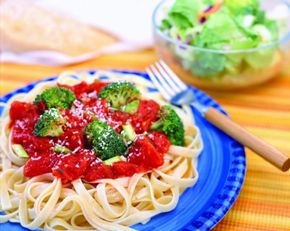Advertisement
- Q. I like to serve pasta to my guests. Is it possible to cook it ahead of time and keep it warm until dinnertime?
- Q. The package instructs me to cook the pasta until "al dente." What does this mean?
- Q. How do you cook rice so that it turns out dry and the grains are separated?
- With all your pasta questions answered, it's time to try cooking some yourself. For some recipe suggestions, visit
Q. I like to serve pasta to my guests. Is it possible to cook it ahead of time and keep it warm until dinnertime?
A. Ideally, pasta should be served immediately after cooking, but we recognize that there are times when making it ahead of time would make entertaining easier.
Here's a suggestion, but it works only for pasta that will be sauced at the table or immediately before serving: Cook the pasta ahead of time, drain, and pour into a bowl that's been rubbed with a little olive oil. (The oil will prevent the pasta from sticking to the bowl after it has cooled.) If you won't be serving the meal for a half hour or more, refrigerate the pasta.
Advertisement
Just before serving, pour the pasta into a large pot of rapidly boiling water. Simmer and stir gently just until the pasta has separated, no more than one minute. Drain, and serve.
Another alternative is to use fresh pasta instead of dry pasta. Fresh pasta requires only a minute or two of stove time, so it can be cooked just before serving.
Advertisement
Q. The package instructs me to cook the pasta until "al dente." What does this mean?
The literal translation of this Italian phrase is "to the tooth." It indicates a degree of doneness when cooking pasta. Al dente pasta is slightly firm and chewy, rather than soft.
Advertisement
Q. How do you cook rice so that it turns out dry and the grains are separated?
Q. How do you cook rice so that it turns out dry and the grains are separated?
A. This pretty much depends on the type of rice you use. There are three commercial grades of rice -- long-, medium- and short-grain -- and the length of the rice kernel affects the texture of the rice when it's cooked. Medium- and short-grain rice have a high starch content, which makes the cooked rice moist and sticky; long-grain rice has less starch, so it cooks up dry and fluffy.
Advertisement
Each type of rice requires a different amount of liquid, so check the cooking directions on the package. For instance, brown rice -- which has been minimally processed -- and converted, or parboiled, rice take longer to cook than white rice and require more liquid (generally 2-1/2 to 3 cups of liquid to 1 cup of rice).
Another way to keep the grains separated is to add about a tablespoon of oil, butter, or margarine to the pot while cooking. This lubricates the individual grains and prevents them from adhering and clumping together.Another bit of advice: Don't stir rice while it's cooking because stirring also will make it stickier.
An easy way to make clump-free rice is to use the pilaf method: Heat 2 tablespoons of butter in a medium saucepan. Add 1 cup long-grain rice. Cook and stir the rice over medium heat for 4 to 5 minutes or until rice turns opaque. Add 2 cups boiling chicken broth or water and 1/2 teaspoon salt. Cover and cook over low heat for 14 minutes or until rice is tender and water has been absorbed.
Q. What is the difference between fresh and dry pasta?
Pasta is classified as either dry or fresh. Dry is the traditional kind sold in a box in the supermarket, while fresh means that it hasn't been dried before packaging.
Fresh pasta is generally limited to long goods-spaghetti, linguine, fettuccine-or filled pastas, such as ravioli and tortellini. The dough is made by combining all-purpose wheat flour, whole eggs, sometimes oil for easier handling, and salt for flavoring. It is blended, kneaded, and then rolled out, either by hand or machine. It is then cut into desired widths.
Commercially made fresh pasta is sold in bulk in natural food markets, Italian markets, and in some regular supermarkets. Packaged fresh pasta is sold in most supermarkets. Fresh bulk pasta is highly perishable and should be used within four or five days. Packaged fresh pastas last longer, since most contain preservatives. Fresh pasta can be double-wrapped and frozen for up to four months, but don't thaw it before cooking; it should go directly from the freezer into the boiling water.
"Specialty" fresh pastas also are available. These have vegetables, herbs, and seasonings added. For instance, spinach lends a green color; carrots, an orange color; beets or tomatoes, a red color; and squid ink, a black color. Common herb and seasoning additions include basil, black pepper, garlic, and lemon.
Fresh pasta doesn't require a long cooking time; most require only a minute or two in rapidly boiling water, so in addition to their fresh appeal, they also get a meal on the table fast.
Advertisement
With all your pasta questions answered, it's time to try cooking some yourself. For some recipe suggestions, visit:
- Baked Pasta with Ricotta Recipe
- Penne with Roasted Chicken & Vegetables Recipe
- Easy Cheesy Lasagna Recipe
- Hearty Noodle Casserole Recipe
- Lemon Broccoli Pasta Recipe
- All Pasta Recipes
Advertisement
